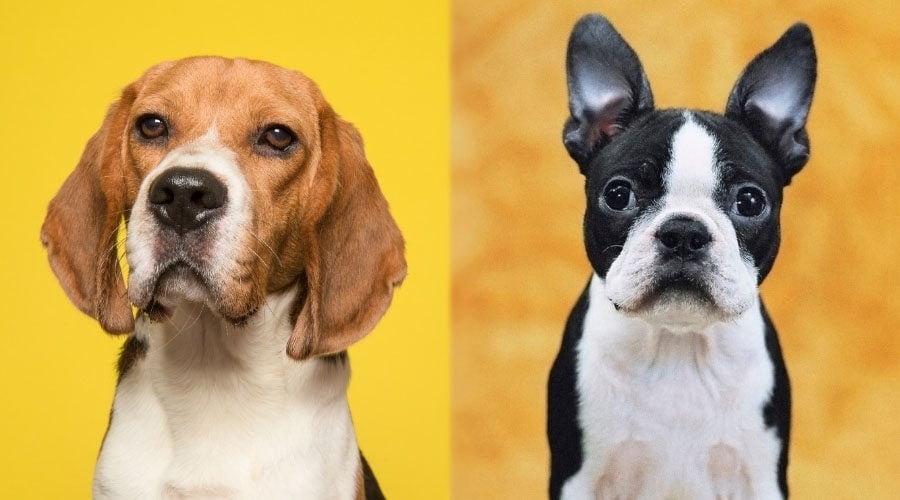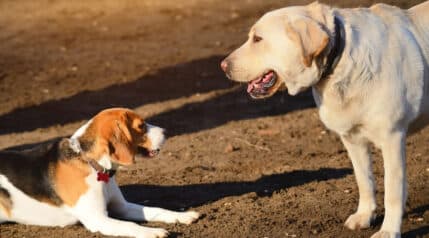Are you comparing the Beagle vs. Boston Terrier for a new family companion? Perhaps you are looking for a dog that’s loyal, affectionate, and playful? Despite being very different in appearance, both of these breeds fit such a description. In fact, because these breeds are so lovable, they are often crossbred into a designer dog breed called the Bolgen Terrier.
You may think there are very few similarities between these two at first glance. But by diving deeper into the personality traits, you’ll understand that they aren’t as different as you think. You’ll also begin to understand why both of these breeds are so popular.
So, whether you’re considering giving into your kids’ plea for a new furry friend, or you’re just curious about these two very lovable dog breeds, you’ve come to the right place. Let’s dive deeper into the similarities and differences between these two family-friendly dog breeds.
Breed Comparison
Beagle
- Height 13-15 Inches
- Weight 18-30 Pounds
- Temperament Loving
- Energy High
- Health Average
- Lifespan 10-15 Years
- Price $1,000 and Up
Boston Terrier
- Height 16 Inches
- Weight 10-25 Pounds
- Temperament Moderately Territorial
- Energy High
- Health Average
- Lifespan 13-15 Years
- Price $1,000 and Up
Breed History
A dog’s breed history can reveal a lot about its current personality traits, including the form, function, and purpose of a dog. Before adopting any dog, it’s important to understand what purpose they were genetically bred for. Certain traits are impossible to remove from a dog’s natural instincts. Below, we will look at the history of both dog breeds, to help you understand what instincts and habits you may be welcoming into your home.
Beagle

As with most breeds, the origin of the Beagle is uncertain. There’s been some debate over where the name “Beagle” originated. Some presume it’s derived from the French word, “begueule,” meaning open throat, while others believe it’s from the English word, “beag,” meaning small. It’s also likely that it comes from the German word, “begele,” which means to scold.
You can find Beagles’ first written mention in Greek documents dating back to 400 B.C, which describe small Beagle-like dogs. Many speculate that the Romans may have brought small hounds designed for rabbit-hunting to England and bred them with the local hounds.
Other studies suggest that William the Conqueror brought back Talbot hounds (which are now extinct) with him to England during the Norman Conquest of 1066, which many think to be the ancestors of modern-day Beagles.
Ever since their discovery, Beagles have been popular amongst English royalty. Elizabeth I kept packs of Pocket Beagles, a smaller variant that only stood nine inches tall. Artists have depicted the breed in paintings as short-legged and pointy-nosed pets.
In the 1700s, the breed was pushed aside from their popular purpose of fox hunting. Instead, farmers in England, Ireland, and Wales continued to use the breed for rabbit hunting. If it wasn’t for these farmers, the Beagle might have become extinct long ago.
Over the next century, both Brits and Americans started breeding packs of Beagles to create the modern Beagle we know and love today. In 1884, The American Kennel Club inducted Beagles into their registry.
Boston Terrier

There are several varying stories about how these pups came to be. Most studies agree that the Boston Terrier came into existence in the late 1800s in Boston, Massachusetts, (hence, its name). One story suggests that wealthy families’ coachmen sought to create a new dog-fighting breed by crossing Bulldogs and English White Terriers (which are now extinct).
Another story suggests that Robert C. Hooper, a local Bostonian, brought a Bulldog/English Terrier mix named “Judge” with him from England in 1865. However, a similar story involving Hooper suggests he bought Judge from another Bostonian breeder in 1870.
Either way, the breed somehow came into existence thanks to little ole’ Judge. According to “The Complete Dog Book,” Judge was described as having a square, blocky head and short, stocky build. Hooper bred Judge just once with another dog, presumably named Kate, and from there, Hooper continued to produce the dog.
In 1889, thirty different owners came together and created the American Bull Terrier Club but later changed their name to the Boston Terrier Club due to the breed’s birthplace.
In 1893, the American Kennel Club officially recognized the breed. Over the next century, Boston Terriers quickly became popular, specifically among Hollywood actors and actresses. In 1976, the Boston Terrier was picked to be the bicentennial dog of the U.S. and was officially named the state dog of Massachusetts three years later.
Appearance

Both dog breeds actually hold no resemblance to one another when it comes to appearance, making them easy to tell apart. Boston Terriers have a clear-cut doppelganger in the French Bulldog, but Beagles look completely different from both breeds.
Boston Terriers are compactly built with square heads. Their stocky, muscular form compliments their pointy, upright ears and smushed snub-nosed appearance. Their sleek, shiny coats come in various brindles, most commonly being a black-and-white pattern resembling a tuxedo. This unique coloring gives them a polished and genuine appearance, but don’t be fooled, these high-energy dogs love to goof around and play.
Most people can quickly recognize a Beagle by its adorable appearance. Their most notable features include big brown or hazel eyes, floppy ears, and pointy noses. Their coat comes in various colors such as lemon, red and white, and tricolor.
Temperament

Both breeds receive much adoration for their loyal, soft and gentle, loving, and affectionate nature. They both make great family dogs for their playful personality, ability to get along with their handlers, and desire to socialize with other dogs.
Compared to Bostons, Beagles are very gentle dogs. While they crave social interaction, they’re not territorial by any means and often shy away from protecting their domain. However, if they become irritated, they may nip. If you’re looking for an acute watchdog, we don’t recommend a Beagle.
Boston Terriers are moderately territorial but prone to biting if tempted. This behavior may be because people initially bred them as fighting dogs. Still, you can avoid this with basic training. If you plan on buying a puppy, we suggest you give them plenty of chew toys to keep them occupied.
Boston Terriers are lively, intelligent, and playful dogs that require frequent attention; otherwise, they may go into periods of loneliness. Fortunately, they adapt well to varying living conditions, so whether you’re a family of five living in a large house, or a couple living in an apartment, and can accommodate any lifestyle.
Exercise

All dogs require exercise to stay healthy and happy, especially both of these breeds. The last thing you want is your frustrated pet to take out their energy on your furniture, so be sure to evaluate how much exercise they need.
When it comes to Boston Terriers, their need for exercise varies from dog to dog. While some Boston’s tire out after a brisk walk, others might need a run or an additional game of fetch or two. Most Bostons require daily exercise to stay in shape. Sticking them outside for hours on end won’t do — feel free to challenge them.
Boston Terriers love to play with their owners. It’s also suggested you bring them to a dog park. Playing with other dogs is a great way to channel their energy.
Beagles are also very active and playful dogs that need at least an hour of daily exercise. They require more physical activity than Boston Terriers. Since people originally bred Beagles to stay in packs, they adore company.
Feel free to take your Beagle on a stroll or participate in other canine sports. They also have a powerful sense of smell, so beware when taking them on long walks — you don’t want your Beagle dashing off in pursuit of a convincing scent.
Training

Both breeds are relatively easy to train. Early socialization and training techniques are vitally important for both breeds to produce results. They both have a stubborn streak, which is something first-time dog owners need to be aware of.
For Beagles, using treats as rewards can be very helpful in the training process. Harsh training techniques, however, will prove to no avail. Since Beagles descend from a history of being eager to please their owners, patience and consistency are key during training.
Boston Terriers are more than willing to please their owner, making them easier to train than Beagles. Their outgoing nature must be taken into consideration, as well. Boston’s need a lot of social interaction, especially starting at a young age. But don’t do it all at once; You don’t want to overwhelm them.
The American Kennel Club says that Bostons respond best when slowly and gradually exposed to new people, places, and situations. It’s important to note their sensitive nature, so be gentle with corrections and swiftly reward good behavior.
Health

Before buying any pet, it’s critical to be aware of potential health risks or concerns. While both breeds are relatively healthy dogs, let’s look at some health factors specific to their breed.
Boston Terriers are prone to eye problems as they grow older, and as an owner, you’ll want to be sure to check their eyes daily for redness and irritation. We suggest you invest in saline solutions to keep their eyes clean and rid of dirt or debris.
Another thing to be aware of is their breathing. Like all snub-nosed dogs, Boston Terriers may experience difficulty breathing in hot or humid areas. While all dogs need to receive plenty of outdoor playtimes, we suggest you keep an eye on this breed to ensure they get adequate shelter from excessive heat exposure.
Beagles are relatively healthy dogs. However, poor breeding practices have left some breeds prone to specific genetic health problems, such as hip dysplasia, patellar luxation, and eye problems. But don’t be alarmed; a reputable breeder will screen the dog for pre-existing conditions.
Also, a Beagles’ large, floppy ears may be adorable, but they should be checked and cleaned weekly. Experts recommend regular teeth cleanings, as well.
Nutrition

Both breeds require high-quality food to maintain proper health. Beagles eat anywhere between 1 to 1.5 cups of dry food, divided into two meals. Boston Terriers can eat a similar amount, ranging from 0.5 to 1.5 cups of dry food per day, divided into two meals.
Whether it’s commercially manufactured or home-prepared, both breeds should do well with any food. Bostons and Beagles are both subject to becoming overweight, so be sure to monitor how much food they’re eating and check with your vet if you notice any significant fluctuations in weight.
Boston Terriers, in particular, have very sensitive stomachs and don’t react well to grains. Even a little bit of low-quality grains can make them bloated and gassy. We also suggest you resist feeding them human food. Providing them breed recommended dog food formulas that can reduce the likelihood of this problem.
On the other hand, Beagles don’t seem to have many significant problems with eating human food. Still, we suggest you do your research on what dogs can and cannot eat.
Grooming

Neither one of these breeds have excessive grooming requirements. Both dogs tend to shed, but not significantly. A Boston’s sleek, fine coat should be groomed weekly, preferably with a soft-bristle brush.
Beagles have a more dense coat, which means Beagles are more prone to seasonal shedding; they require brushing two to three times a week with a medium-bristle brush or rubber grooming tool.
Both breeds shouldn’t be bathed too often (unless they get into something messy). You should wash a Boston every four to six weeks to keep him looking clean and fresh. Beagles have sensitive skin and should only receive a bath every two to six months.
Price

Boston Terriers and Beagles have similar price ranges. On average, a Boston Terrier’s price ranges from $1,000 and up, with the average being around $1,500. A Beagle’s price range is around $1,000 as well, but with an average of closer to $1,200 from a reputable breeder.
Breeder reputation and the puppy’s lineage factor into the cost. A Beagle puppy with an exceptional breed line costs $1,500 or higher. A top-quality Boston with a high-end lineage can cost between $1,500-$4,500.
Final Thoughts
That just about wraps up everything you need to know about these two lovable breeds! There’s no doubt both these lovable and playful dogs make great family pets. Comparing the similarities and differences can help you pick the best dog for your lifestyle.
Boston’s are intelligent, happy, and lively dogs that can adapt to any environment. Beagles are amiable yet excitable dogs who love company and adore attention from their owners. Both breeds are known for their fun-loving nature, and either one would make a great addition to the family.





